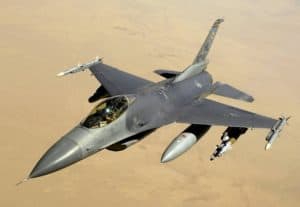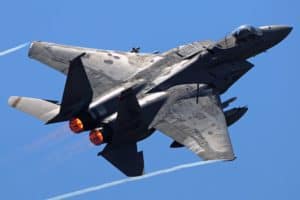When it comes to modern aerial warfare, the F-15 and F-16 fighter jets are among the most legendary and iconic aircraft in the world. Both produced by American aerospace giant McDonnell Douglas (now part of Boeing), these aircraft have played vital roles in shaping air combat strategies for decades. In this article, we’ll delve into the details of the F-15 and F-16, comparing their design, performance, mission roles, and more to determine which reigns supreme in the skies.
Advertisement
Table of Contents
Overview of F-15:
The F-15, also known as the “Eagle,” entered service with the United States Air Force in the early 1970s. It was designed primarily for air superiority missions and has since proven itself in numerous conflicts worldwide. With its twin-engine configuration, the F-15 boasts impressive speed and maneuverability, making it a formidable opponent in dogfights.
Overview of F-16:
The F-16, commonly referred to as the “Fighting Falcon,” made its debut in the mid-1970s. It was initially intended as a lightweight, cost-effective alternative to the F-15, with a single-engine setup. Despite its lighter build, the F-16’s agility and advanced fly-by-wire controls give it a significant edge in aerial combat scenarios.
Advertisement
Technical Specification:
| Aircraft: | Lockheed Martin F-16 Fighting Falcon | McDonnell Douglas F-15 Eagle |
|---|---|---|
| Photo: |  |  |
| Country: | United States | United States |
| Manufactured: | from: 1978 to: Present | from: 1972 to: Present |
| ICAO: | – | F15 |
| Price: | $18 million | $29.9 million |
| Avionics: | Lockheed Martin Tactical Aircraft Systems | F15 HUD, APG-63 and 70 pulse-Doppler radar |
| Engine: | 1 × Pratt & Whitney F100-PW-220 | 2x Pratt & Whitney F100-PW-220 |
| Engine Type: | – | Turbofan |
| Power: | 29,160 pound-force | 23,770 pound-force |
| Max Cruise Speed: | 1147 knots 2,124 Km/h | 1630 knots 3,019 Km/h |
| Approach Speed (Vref): | – | 250 knots |
| Travel Range: | 2,280 Nautical Miles 4,223 Kilometers | 3,000 Nautical Miles 5,556 Kilometers |
| Fuel Economy: | – | – |
| Service Ceiling: | 50,000 feet | 65,000 feet |
| Rate of Climb: | 50000 feet / minute 254.00metre / second | 50000 feet / minute 254.00metre / second |
| Take Off Distance: | 345 metre 1,131.88 feet | 275 metre 902.22 feet |
| Landing Distance: | 457 metre 1,499.33 feet | 1100 metre 3,608.88 feet |
| Max Take Off Weight: | 19,187 Kg 42,300 lbs | 30,844 Kg 67,999 lbs |
| Max Landing Weight: | – | 20,185 Kg 44,500 lbs |
| Max Payload: | 7,167 Kg 15,800 lbs | 10,659 Kg 23,499 lbs |
| Fuel Tank Capacity: | 845 gallon 3,199 litre | 4,345 gallon 16,448 litre |
| Baggage Volume: | – | – |
| Seats – Economy: | 1 seats | 1 seats |
| Seats – Business Class: | – | – |
| Seats – First Class: | – | – |
| Cabin Height: | – | – |
| Cabin Width: | – | – |
| Cabin Length: | – | – |
| Exterior Length: | 15.06 metre 49.41 feet | 19.43 metre 63.75 feet |
| Tail Height: | – | 5.64 metre – 18.50 feet |
| Fuselage Diameter: | – | – |
| Wing Span / Rotor Diameter: | 9.96 metre 32.68 feet | 13.06 metre 42.85 feet |
| Wing Tips: | No Winglets | No Winglets |
| More Info: | Lockheed Martin F-16 Fighting Falcon | McDonnell Douglas F-15 Eagle |
| Data presented is for entertainment purposes and should not be used operationally. |
Comparison of Design and Structure:

Airframe and Size:
The F-15’s larger airframe allows it to carry a substantial payload and fuel capacity, granting it extended range and endurance. On the other hand, the F-16’s compact size and lightweight design make it highly maneuverable and harder to detect on radar.
Power and Engine:
The F-15’s twin Pratt & Whitney engines generate immense thrust, enabling it to reach supersonic speeds without afterburners. In contrast, the F-16’s single General Electric engine provides excellent thrust-to-weight ratio, contributing to its exceptional acceleration and agility.
Avionics and Electronics:
Both aircraft are equipped with state-of-the-art avionics, radar systems, and electronic warfare suites. The F-15’s radar has a longer range, while the F-16’s radar is more compact but equally potent, optimized for dogfighting and close-range combat.
Weapons and Armament:
Both fighters can carry an impressive array of air-to-air and air-to-ground weapons. The F-15, with its larger size, has more hardpoints, allowing it to carry a greater variety of munitions. The F-16, though, can still carry an impressive payload and is often lauded for its precision strike capabilities.
Advertisement
Performance Comparison:

Speed and Maneuverability:
The F-15’s twin engines give it a slight advantage in raw speed, and its thrust-to-weight ratio contributes to excellent climb rates. However, the F-16’s exceptional agility and fly-by-wire controls make it a master of close-quarters combat and high-G maneuvers.
Range and Endurance:
With its larger fuel capacity, the F-15 can cover greater distances without refueling, making it suitable for long-range missions. The F-16, though not as fuel-efficient, compensates with aerial refueling capabilities and superior loiter time.
Combat Capabilities:

Both aircraft have advanced radar systems and can engage multiple targets simultaneously. The F-15’s radar, with its longer range, allows it to detect enemy aircraft from a greater distance, providing more time to prepare for engagements. The F-16, however, is renowned for its ability to outmaneuver opponents in close-quarters combat.
Dogfighting and Air-to-Air Combat:
In a dogfight, the F-16’s agility and fly-by-wire controls give it a considerable advantage, allowing it to outmaneuver most adversaries. The F-15, while not as nimble, can rely on its speed, power, and advanced weapons systems to take on multiple opponents at once.
Additional Read: Hermeus Is Plugging An F-15 Engine Into its Hypersonic Test Aircraft
Advertisement
Mission Roles and Specializations:
Air Superiority:
The F-15 was specifically designed for air-to-air combat and excels in maintaining air superiority. Its powerful engines and radar capabilities make it an intimidating opponent in aerial battles.
Ground Attack and Strike Missions:
The F-16’s versatility shines in ground attack missions, where its precision-guided munitions and nimble handling make it effective against ground targets.
Multirole Capabilities:
The F-16’s adaptability allows it to perform a wide range of missions, from air defense to ground support, making it a highly sought-after multirole fighter.
Variants and Upgrades:
Over the years, both the F-15 and F-16 have undergone numerous upgrades and variants to meet changing operational requirements and incorporate advancements in technology.
Operators and Global Presence:
F-15 Operators:
The F-15 serves in the air forces of several countries, including the United States, Israel, Japan, and Saudi Arabia, among others.
F-16 Operators:
The F-16 has an even broader international presence, with over 25 countries operating various versions of the aircraft.
Use in Different Countries:
Both fighters have participated in various conflicts worldwide and have proven their combat effectiveness on numerous occasions.
Cost and Affordability:
The F-16’s single-engine design and lower production costs make it more budget-friendly compared to the F-15, which boasts a higher price tag due to its twin-engine setup and larger size.
Additional Read: Boeing F-15EX deliveries slip at least six months after quality errors
Advertisement
Future Prospects and Upcoming Technologies:
F-15 Future:
The F-15 is set to continue its service for many years to come, with upgrades and modernizations planned to keep it relevant in modern warfare.
F-16 Future:
As newer generations of fighters enter service, the F-16’s role is gradually shifting to complementing advanced aircraft, serving as a cost-effective option for air forces around the world.
Integration with Next-Gen Aircraft:
Both the F-15 and F-16 will likely be integrated with next-generation aircraft and systems to maintain their relevance and combat effectiveness in the future.
AI and Autonomous Features:
As technology advances, both aircraft may incorporate AI-driven systems and autonomous features to enhance their capabilities further.
Conclusion:
In conclusion, the F-15 and F-16 are two remarkable fighter aircraft, each with its strengths and specializations. The F-15 shines in air-to-air combat and air superiority, while the F-16’s versatility and agility make it a formidable multirole fighter. Ultimately, the choice between these two exceptional aircraft depends on the specific requirements and missions of the air force operating them.
FAQs:
Q: Which fighter is faster, the F-15 or the F-16?
A: The F-15 has a higher top speed, but the F-16’s agility gives it an edge in certain maneuvers.
Q: Can the F-15 and F-16 carry nuclear weapons?
A: Both aircraft are capable of carrying nuclear munitions, although they are primarily used for conventional warfare.
Q: How many countries operate the F-15 and F-16?
A: The F-15 serves in the air forces of several countries, while the F-16 is used by over 25 nations.
Q: Are there newer versions of the F-15 and F-16 in development?
A: Upgrades and modernizations for both aircraft are ongoing, ensuring their relevance in modern combat scenarios.
Q: What is the approximate cost difference between the F-15 and F-16?
A: The F-16 is generally more affordable due to its single-engine design and lower production costs.